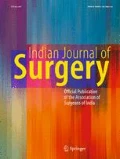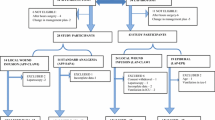Abstract
Control of acute postoperative pain is a requirement in modern surgical practice. Opioid and non-opioid analgesics and epidural analgesia (EA) are used to achieve relief from postoperative pain. Each of these has its share of difficulties and complications. Continuous wound infusion (CWI) of local anaesthetics has also been employed. This study aims to compare CWI with EA in managing postoperative pain. In a randomized controlled study, patients undergoing laparotomy were allocated into two groups prior to surgery: Group 1 received epidural analgesia postoperatively and group 2 received continuous wound infusion of local anaesthetic postoperatively. The study compared the quality of postoperative analgesia measured using a standard validated visual analogue scale (VAS), the frequency and dosage of rescue analgesia over 48 h postsurgery, bowel recovery time, complications due to pain, and hospital stay. Forty-two patients were included in the study. The two groups being studied were statistically comparable. The pain scores were lower in the wound infusion group at the second (p = 0.03), third (p = 0.035), and fourth time (p < 0.01) interval recordings (at p = 0.05) compared with those in the epidural group. Rescue analgesia usage was seen to be greater in the epidural group at the first (p = 0.041), second (p = 0.01), and fifth (0.007) time interval recording (at p = 0.05). Time of independent mobilization and duration of hospital stay were 1.7 days and 5.6 days respectively and were seen to be significantly lower in the wound infusion group (p < 0.05). Continuous wound catheter infusion of local anaesthetic is as effective as epidural analgesia in treating postoperative pain. Continuous wound infusion catheter may be a better alternative because of the ease of institution, early ambulation, and shorter duration of hospital stay.

Similar content being viewed by others
References
Almeida MCS, Locks GF, Gomes HP, Brunharo GM, Kauling ALC (2011) Postoperative analgesia: comparing continuous epidural catheter infusion of local anesthetic and opioid and continuous wound catheter infusion of local anesthetic. Rev Bras Anestesiol 61(3):293–303
Thornton PC, Buggy DJ (2011) Local anaesthetic wound infusion for acute postoperative pain: a viable option? Br J Anaesth 107(5):656–658
Xin Y, Hong Y, Yong LZ (2014) Efficacy of Postoperative continuous wound infiltration with local anesthesia after open hepatectomy. Clin J Pain 30(7):571–576
White PF (2005) The changing role of non-opioid analgesic techniques in the management of postoperative pain. Anesth Analg 101:S5–S22
Davignon KR, Maslow A, Chaudrey A, Ng T, Shore-Lesserson L, Rosenblatt MA (2008) Epidural hematoma: when is it safe to heparinize after the removal of an epidural catheter? J Cardiothorac Vasc Anesth 22:774–778
Abreu MP, Deda RG, Cangiani LH et al (2004) Abscesso peridural após analgesia controlada pelo paciente por via peridural. Relato de caso. Rev Bras Anestesiol 54:78–83
Etches RC, Sandler AN, Daley MD (1989) Respiratory depression and spinal opioids. Can J Anaesth 36(2):165–185
Savoie FH, Field LD, Jenkins RN, Mallon WJ, Phelps RA (2000) The pain control infusion pump for postoperative pain control in shoulder surgery. Arthroscopy 16:339–342
Raines S, Hedlund C, Franzon M, Lillieborg S, Kelleher G, Ahlén K (2014) Ropivacaine for continuous wound infusion for postoperative pain management: a systematic review and meta-analysis of randomized controlled trials. Eur Surg Res 53:43–60
Aguirre J, Bailing B, Dora C, Ekatodramis G, Votta-Velis G et al (2012) Continuous epicapsular ropivacaine 0.3% infusion after minimally invasive hip arthroplasty: a prospective, randomized, double-blinded, placebo-controlled study comparing continuous wound infusion with morphine patient-controlled analgesia. Anesth Analg 114:456–461
Beaussier M, El’Ayoubi H, Schiffer E et al (2007) Continuous preperitoneal infusion of ropivacaine provides effective analgesia and accelerates recovery after colorectal surgery – a randomized, double-blind, placebo-controlled study. Anaesthesiology 107:461–468
Chan SK, Lai PB, Li PT, Wong J, Karmakar MK, Lee KF, Gin T (2010) The analgesic efficacy of continuous wound instillation with ropivacaine after open hepatic surgery. Anaesthesia 65:1180–1186
Block BM, Liu SS, Rowlingson AJ, Cowan AR, Cowan JA Jr, Wu CL (2003) Efficacy of postoperative epidural analgesia: a meta-analysis. J Am Med Assoc 290:2455–2463
Kehlet H, Dahl J (2003) Anaesthesia, surgery, and challenges in postoperative recovery. Lancet. 362:1291–1298
Marhofer P, Harrop-Griffiths W, Willschke H, Kirchmair L (2011) Fifteen years of ultrasound guidance in regional anaesthesia: part 2—recent developments in block techniques. Br J Anaesth 104:673–683
Dagtekin O, Hotz A, Kampe S, Auweiler M, Warm M (2009) Postoperative analgesia and flap perfusion after pedicled TRAM flap reconstruction – continuous wound instillation with ropivacaine 0.2%. A pilot studies. J Plast Reconstr Aesthet Surg 62:618–625
Forastiere E, Sofra M, Giannarelli D, Fabrizi L, Simone G (2008) Effectiveness of continuous wound infusion of 0.5% ropivacaine by On-Q pain relief system for postoperative pain management after open nephrectomy. Br J Anaesth 101:841–847
Blumenthal S, Dullenkopf A, Rentsch K, Borgeat A (2005) Continuous infusion of ropivacaine for pain relief after iliac crest bone grafting for shoulder surgery. Anesthesiology. 102:392–397
Forastiere E, Sofra M, Giannarelli D, Fabrizi L, Simone G (2008) Effective- ness of continuous wound infusion of 0.5% ropivacaine by On-pain relief system for postoperative pain management after open nephrectomy. Br J Anaesth 101:841–847
Liu SS, Richman JM, Thirlby RC, Wu CL (2006) Efficacy of continuous wound catheters delivering local anesthetic for postoperative analgesia: a quantitative and qualitative systematic review of randomized controlled trials. J Am Coll Surg 203:914–932
Tan KJ, Farrow H (2009) Improving postoperative analgesia for transverse rectus abdominis myocutaneous flap breast reconstruction; the use of a local anaesthetic infusion catheter. J Plast Reconstr Aesthet Surg 62:206–210
Clavien PA, Barkun J, de Oliveira ML, Vauthey JN, Dindo D, Schulick RD, de Santibañes E, Pekolj J, Slankamenac K, Bassi C, Graf R, Vonlanthen R, Padbury R, Cameron JL, Makuuchi M (2009) The Clavien-Dindo classification of surgical complications. Five-year experience. Ann Surg 250:187–196
Kucha’lik J, Granath B, Ljunggren A et al (2013) Postoperative pain relief after total hip arthroplasty: a randomized, double-blind comparison between intrathecal morphine and local infiltration analgesia. Br J Anaesth 111(5):793–799
Lunn TH, Husted H, Solgaard S, Kristensen BB, Otte KS, Kjersgaard AG, Gaarn-Larsen L, Kehlet H (2011) Intraoperative local infiltration analgesia for early analgesia after total hip arthroplasty: a randomized, double-blind, placebo-controlled trial. Reg Anesth Pain Med 36:424–429
Author information
Authors and Affiliations
Corresponding author
Ethics declarations
Conflict of Interest
The authors declare that they have no conflicts of interest.
Research Involving Human Participants
This is a comparative study of two modalities of analgesia. Similar studies have been done proving the efficacy of the newer technique. Our study methodology was based on recommendations from previous studies on the subject.
Informed Consent
Patients were explained about the nature of interventions being studied before recruitment into the study. The inclusion into the study was done only after obtaining an informed consent.
Additional information
Publisher’s Note
Springer Nature remains neutral with regard to jurisdictional claims in published maps and institutional affiliations.
Electronic Supplementary Material
ESM 1
(DOCX 86 kb)
Rights and permissions
About this article
Cite this article
Ramesh, V., Aspari, A.R., Lakshman, K. et al. Postoperative Analgesia: Randomized Prospective Study Comparing Epidural Catheter Infusion and Continuous Wound Catheter Infusion of Local Anaesthesia. Indian J Surg 82, 1067–1073 (2020). https://doi.org/10.1007/s12262-020-02243-6
Received:
Accepted:
Published:
Issue Date:
DOI: https://doi.org/10.1007/s12262-020-02243-6




